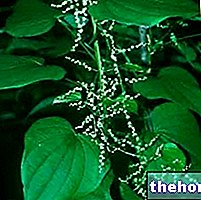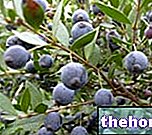Foeniculum vulgare Mill.
Apiaceae family (Umbelliferae) Nutritional values fennel - Fennel herbal tea - Fennel in Herbalist's shop
Fr. Fenouil
lng. Fennel
Sp. Hinojo
Ted. Fenchel
Description
Biennial or perennial herbaceous plant, up to 2 meters high. The stem is erect, cylindrical, branched, striated, a little glaucous.
The leaves, divided into numerous filiform laciniae, embrace the stem with a wide sheath. The root is taproot and bifid in the distal part.
The hermaphrodite flowers are small, yellow and gathered in terminal umbels composed of 10-30 rays. The sepals are absent, the corolla is made up of 5 oblong, whole, crumpled petals. It blooms in the summer. The fruit is a hairless diachene, with welded mericarps provided with five ribs, pale green, oblong or slightly arched, very aromatic due to the presence of an essence contained in six secretory pockets (vitte). All parts of the plant have aroma intense and spicy flavor.

Different varieties of fennel are known: the dulce or romano, cultivated for the fruits from which the essence is obtained and cultivated as a vegetable for the large fleshy leaf sheaths; the capillaceum (wild fennel), perennial present in the peninsula and in the islands of " Istria (uncultivated grass, escarpments, roadsides); the annual forms sativum, cultivated for the aromatic achenes; the variety piperitum with Mediterranean distribution perennial with fruits and acrid and unpleasant taste.
Areal
Fennel is believed to originate in Asia Minor, but it was widespread throughout the Mediterranean area: in fact it was known by the Egyptians, Greeks and Arabs. Today the major production areas are represented by India, Egypt, Pakistan, China, Indonesia and Argentina.
Cultivation, harvesting and yields
The crop, which lasts two years, is planted in February-March, by direct sowing with "seeds" of recent production, otherwise dormancy phenomena may occur which prevent germination.
Sowing, between 4 and 6 kg / ha, is usually carried out in rows spaced 50 cm apart.
Fertilization: fennel reacts positively to the richness of phosphorus in the soil; consequently it is advisable to administer, at sowing, abundant phosphate fertilizations (100-150 kg / ha), while more modest contributions are sufficient for potassium. As far as nitrogen is concerned, it is advisable not to exceed; usually 50-60 kg / ha after the emergence of the crop, followed by another similar dose in the spring of the second year, may be sufficient to satisfy the needs of the plant.
The crop is undemanding to water.
When the crop is destined for the production of leaves, mowing is done at the beginning of summer, before the inflorescence is released. In this case, a second mowing can also be carried out in late summer.
The harvest of the fruits is carried out mechanically in September of the second year, when those of the central umbrella have assumed a light yellow color. After harvesting, the fruits are cleaned from the inflorescence, and then dried at a temperature not exceeding 40 ° C.
The yield in leaves is 8-10 t / ha of fresh material which when dried is reduced to 1.5-2.5 t / ha.
Fruit production, in a good crop, can vary from 1 to 1.5 t / ha
The fruits provide an essential oil yield of 4-5% with respect to the dry weight.
The oil yield of the dry plant, excluding fruits, is 0.4-0.5%.
The quality of the essence is better in cultivation stations located at high altitudes (800 m a.s.l.) than in those at lower altitudes.
Drug
It is made up of dried fruits destined for the extraction of the essential oil, which is spread out for about 60% in the fruits and the remainder in the rays of the umbels and in the other green parts of the plant; The essence, greenish in color, is made up for about 70% from anethole and for the remainder from various other substances. Over 30 have been identified so far; the most represented ones are fencone, methylcavicum, estragon, pinene, in addition to myrcene, limonene and phellandrene. they can be used to assess the age of the oil) or others with estrogenic properties. It is very important to strictly respect the prescribed doses since anethole in high doses causes convulsions.
Fennel - Properties and uses in herbal medicine - MypersonaltrainerTv Videos
Watch the video
- Watch the video on youtube
Uses
In dietetics: the fruits are used in liqueurs, in confectionery and as flavoring of cured meats and appetizers; stems and leaf sheaths are consumed in salads or to give flavor to broths and roasts.
Fennel, in addition to being rich in vitamins and mineral salts, are rich in active ingredients that make them particularly useful for: gout, asthenia, loss of appetite, rheumatism, flatulence, vomiting, weak eyesight.
Being rich in flavonoids or phytoestrogens, natural estrogenic substances, fennel has a balancing effect on female hormone levels, can promote the regularization of the menstrual cycle, milk secretion and prevent breast cancer. It acts on the liver and detoxification systems by regulating and improving liver function. It also acts on the nervous system by preventing and / or relieving muscle spasms.
The fruits of fennel, improperly called seeds, contain volatile oils in quantities ranging between 0.8 and 4%. Among these, the main constituents are a sweet essential oil, the anethole, and a bitter substance, the phenicicon. The well-known stimulating action on the motility of the stomach and intestine (carminative), which makes the seeds of fennel particularly useful in the presence of meteorism and flatulence. The same essential oils can also be attributed to the increase, by reflex phenomenon, of salivary secretion.
In herbal medicine and phytopharmacy, fennel is indicated against dyspepsia, stomach heaviness, flatulence, meteorism, colitis, digestive atony, cough, inflammation of the airways. It also has estrogenic, anti-fermentative, expectorant activity, and is useful against menstrual problems.
For further information: Fennel seeds
Light Fennel Gratin
Problems with playing the video? Reload the video from youtube.
- Go to the Video Page
- Go to the Video Recipes Section
- Watch the video on youtube























-nelle-carni-di-maiale.jpg)




